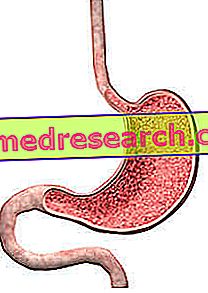Generality
Stevens-Johnson syndrome is a rare and serious hypersensitivity reaction that involves the involvement of the skin and mucous membranes.

Often a consequence of taking certain types of drugs, Stevens-Johnson syndrome can sometimes be caused by infections or other factors.
Skin desquamation is one of the characteristic symptoms of the syndrome in question; patients who undergo its development are generally hospitalized and subjected to the necessary care and support treatments. If the syndrome is caused by drugs, their intake should be stopped immediately.
If promptly diagnosed, the prognosis is generally good.
What is that
What is Stevens-Johnson Syndrome?
Stevens-Johnson syndrome is an acute hypersensitivity reaction generally (but not always) triggered by medication. It is characterized by the destruction and detachment of the skin epithelium and mucous membranes (necrolysis) whose consequences can be extremely serious.
The annual incidence of Stevens-Johnson syndrome is about 1-5 / 1, 000, 000, therefore, this is fortunately a very rare reaction.
Several sources consider Stevens-Johnson syndrome as a limited variant of toxic epidermal necrolysis (or Lyell syndrome, a particular type of polymorphic erythema), characterized by a similar but more extensive and serious symptomatology than that of Stevens-Johnson syndrome.
Stevens-Johnson syndrome and Toxic Epidermal Necrolysis: what differences?
The symptoms of Stevens-Johnson syndrome and toxic epidermal necrolysis are very similar. Both are characterized by the destruction and subsequent desquamation of the skin which, however, affects limited body areas ( less than 10% of the entire body surface) in the object syndrome. while in toxic epidermal necrolysis it involves more extensive areas of skin ( over 30% of the body surface).
The involvement from 15% to 30% of the skin surface is, instead, considered as an overlap between Stevens-Johnson syndrome and toxic epidermal necrolysis.
Causes
What are the Causes of Stevens-Johnson Syndrome?
As mentioned, in most cases, Stevens-Johnson syndrome is the consequence of a hypersensitivity reaction triggered by medication. However, the latter are not the only possible cause of the syndrome in question.
In other cases, finally, although rare, it is not possible to identify the cause.
drugs
Among the drugs known to be potentially capable of inducing Stevens-Johnson syndrome, we recall:
- Antibacterial drugs and antibiotics, such as:
- Sulfonamides (such as, for example, cotrimoxazole and sulfasalazine);
- Amoxicillin, ampicillin and other penicillins;
- Fluoroquinolones;
- Cephalosporins;
- Etc.
- Antiepileptic drugs (such as, for example, carbamazepine, lamotrigine, valproate, phenobarbital and phenytoin);
- Non-steroidal anti-inflammatory drugs (NSAIDs);
- Barbiturates ;
- Piroxicam ;
- Allopurinol .
Other Causes
Other possible causes responsible for the onset of Stevens-Johnson syndrome are:
- Infections of a viral or bacterial nature (in particular, supported by Mycoplasma pneumoniae );
- The administration of some types of vaccines ;
- Transplant disease against the host (or GVHD, from the English Graft-Versus-Host Disease).
Which people are at risk for developing Stevens-Johnson syndrome?
The risk of Stevens-Johnson syndrome is greater:
- In HIV positive and AIDS patients;
- In patients with impaired immune system (eg due to drugs);
- In patients with infections due to Pneumocystis jirovecii ;
- In patients with systemic lupus erythematosus;
- In patients suffering from chronic rheumatic diseases;
- In patients with a past history of Stevens-Johnson syndrome.
Pathophysiology
How and why does Stevens-Johnson Syndrome manifest?
The mechanism underlying the onset of Stevens-Johnson syndrome is, in reality, still unknown, although the hypotheses made about it are different. Among these, we recall the following:
- Theory of altered drug metabolism : according to this theory, following an altered drug metabolism (consisting, for example, in an inadequate elimination of reactive metabolites), in some patients there is a cytotoxic reaction mediated by T cells against of the reactive metabolites mentioned above.
- Granulisin theory : according to this theory it would be granulisin released from T cells and natural killer cells that play a key role in keratinocyte death and in the severity of manifestations of Stevens-Johnson syndrome.
- FAS receptor theory and its ligand : this theory hypothesizes that cell death and blistering typical of the syndrome in question is closely related to the interaction of the FAS membrane receptor (a receptor that, if activated, induces cell apoptosis) with its ligand in soluble form.
Finally, the hypothesis of the existence of a certain genetic predisposition to the development of Stevens-Johnson syndrome has also been advanced.
Symptoms
Symptoms induced by Stevens-Johnson Syndrome
As already mentioned, the characteristic symptom of Stevens-Johnson syndrome is represented by the destruction and consequent marked desquamation of the skin tissue, to which is added the involvement of the mucous membranes . However, skin lesions are not the first symptom with which the syndrome manifests itself. The latter, in fact, begins with the appearance of systemic and non-specific symptoms ( prodromal symptoms ) and then leaves space only in a second moment to the cutaneous manifestations that distinguish it.
Prodromal Symptoms
The prodromal symptoms with which the Stevens-Johnson syndrome usually begins are systemic and consist of:
- Temperature;
- Headache;
- Cough;
- Fatigue;
- keratoconjunctivitis;
- Generalized aches and pains.
At this stage, many patients may also experience a burning sensation and / or unexplained pain to the skin.
In the event that Stevens-Johnson syndrome is caused by medication, the prodromal symptoms mentioned above appear within 1-3 weeks after the start of therapy. The symptoms of skin and mucous membranes described below, however, appear 4-6 weeks after the beginning of the same.
Symptoms of skin and mucous membranes
After the appearance of the aforementioned prodromal symptoms, the symptoms of skin and mucous membranes arise. They start with a flat and reddened rash that generally starts from the face, neck and trunk and then spreads to the rest of the body. In the specific case of Stevens-Johnson syndrome, this eruption affects less than 10% of the body surface.
After the rash appears , blisters follow and tend to exfoliate within 1-3 days. Blisters can also appear at the level of the genitals, hands, feet; appear on the mucous membranes (for example, of the mouth, throat, etc.) and may even involve internal epithelia, such as those in the airways, urinary tract, etc. Also the eyes are generally affected by the formation of blisters and crusts: they appear swollen, reddened and painful.
In addition to marked skin peeling, you may also experience nail and hair loss.
Clearly, in such a condition, the patient perceives a considerable pain which is associated with an equally noticeable swelling . Furthermore, depending on the areas in which the blisters form and where the desquamation occurs, the patient may develop difficulty breathing, difficulty in urinating, difficulty keeping the eyes open, difficulty swallowing, talking, eating and even drinking.
Complications of Stevens-Johnson Syndrome
Complications of Stevens-Johnson syndrome occur mainly due to necrosis and the consequent peeling of skin and mucous membranes. In the absence of the barrier function typically exercised by the skin, in fact, we can meet:
- Large loss of electrolytes and liquids ;
- Contraction of various types of infections (bacterial, viral, fungal, etc.) which can also lead to sepsis .
Another serious complication consists in the onset of insufficiency of various organs (multiorgan failure).
Diagnosis
How is Stevens-Johnson Syndrome Diagnosed?
The diagnosis of Stevens-Johnson syndrome can be made by the simple clinical evaluation of the patient, observing the lesions of the skin and mucous membranes. In addition to this, it is also possible to perform a skin biopsy with consequent histological examination, although this is not a frequently performed procedure.
Unfortunately, early diagnosis, when the syndrome is still in its initial phase and manifests itself with prodromal symptoms, is not always possible. In fact, since these symptoms are rather non-specific, an incorrect assessment could be made, with a consequent delay in identifying the real cause of the patient's illness.
With what diseases should Stevens-Johnson Syndrome not be confused?
The manifestations and symptoms induced by Stevens-Johnson syndrome could be similar to those induced by other pathologies involving skin and mucous membranes, with which, however, it should not be confused. More in detail, the differential diagnosis must be placed against:
- Polymorphic minor and major erythema;
- Of toxic epidermal necrolysis or Lyell's syndrome, if you prefer;
- Toxic shock syndrome;
- Of exfoliative dermatitis;
- Of pemphigus.
Treatments and Treatments
Possible Cures and Treatments of Stevens-Johnson Syndrome
Treatment of Stevens-Johnson syndrome generally requires hospitalization, depending on the timeliness of the diagnosis - ie the extent of the reported skin lesions and scaling - in a dermatology department, or in the intensive care unit, in order to avoid the onset of potentially fatal complications (eg, infections and sepsis).
If the syndrome is caused by taking drugs, treatment with them should be stopped immediately.
Unfortunately, even if there are some drugs that can be administered to try to stop the progression of the syndrome, we cannot speak of a real cure for Stevens-Johnson syndrome. In any case, patients admitted because they suffer from the syndrome in question must receive adequate support treatments .
Support Therapy
Supportive care is essential to ensure patient survival. It may vary depending on the conditions of the latter.
- Lost fluids and electrolytes will have to be administered parenterally . A similar discourse with regard to nutrition if the patient is not able to do this independently due to the lesions on the skin and mucous membranes of the mouth, throat, etc.
- Patients with eye involvement will need to make specialist visits and be subjected to targeted treatments to prevent, or at least limit, the damage caused by the syndrome.
- Skin lesions typical of Stevens-Johnson syndrome should be treated daily and treated in the same way as burns.
- In the presence of secondary infections, it is necessary to proceed with the treatment of the latter, establishing appropriate therapies against the triggering pathogen (using, for example, antibiotic drugs - as long as they are not known to induce the syndrome in question - antifungal drugs, etc.). .
Drugs to Reduce the Duration of Stevens-Johnson Syndrome
In an attempt to stop Stevens-Johnson syndrome or otherwise reduce its duration, it is possible to use drugs such as:
- Ciclosporin, administered to inhibit the action of T cells .
- Corticosteroids for systemic use, in order to dampen the action of the immune system, but at the same time useful for combating pain .
- High dose IV immunoglobulins ( IgEV ); administered early. They should stop the activity of antibodies and block the action of the FAS receptor ligand .
However, the use of these medicines is the subject of conflicting opinions among doctors .
The use of corticosteroids, in fact, is related to an increase in mortality and can favor the appearance of infections or mask a possible sepsis; although these drugs have shown some effectiveness in improving eye injuries.
Similarly, although the administration of IgEV allows to obtain good initial results, according to clinical trials and retrospective analyzes, the final results obtained are contrasting. In fact, from these experiments and analyzes it emerged that IgEVs can be not only ineffective but potentially connected to an increase in mortality.
Other Treatments
In some cases, plasmapheresis can also be performed, in order to remove residues of reactive drugs and antibody metabolites that could represent the triggering cause of Stevens-Johnson syndrome.
However, the most indicated treatment for each patient will be established by the doctor based on the condition of the patient and on the basis of the phase in which Stevens-Johnson syndrome is found when it is diagnosed.
Prognosis
What is the Prognosis of Stevens-Johnson Syndrome?
The Stevens-Johnson syndrome itself - therefore, with the involvement of less than 10% of the body surface - presents a mortality rate of about 1-5% . However, these percentages are reduced in the case of early treatment. Therefore, if promptly diagnosed and treated, the prognosis of Stevens-Johnson syndrome could be good.



